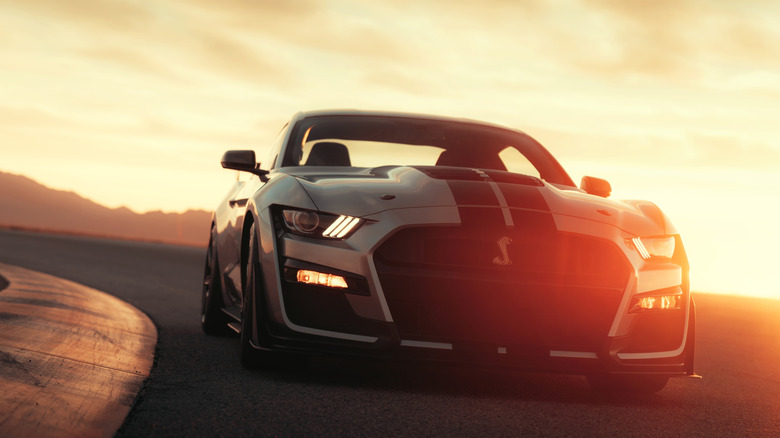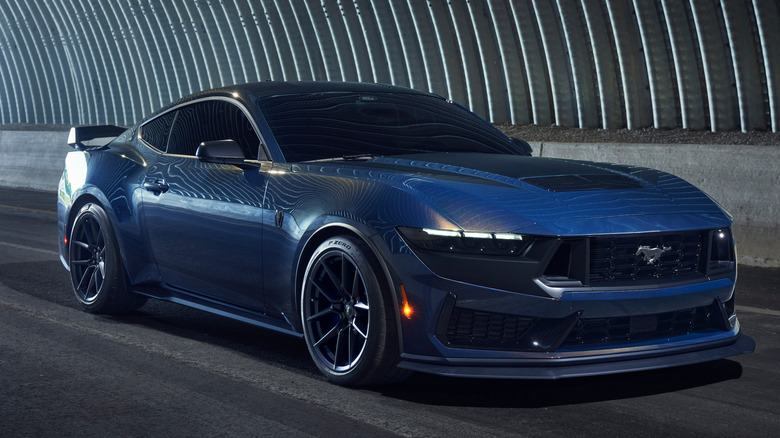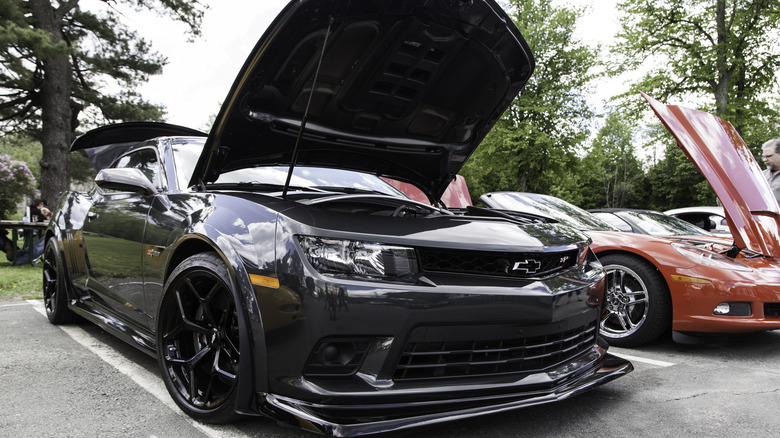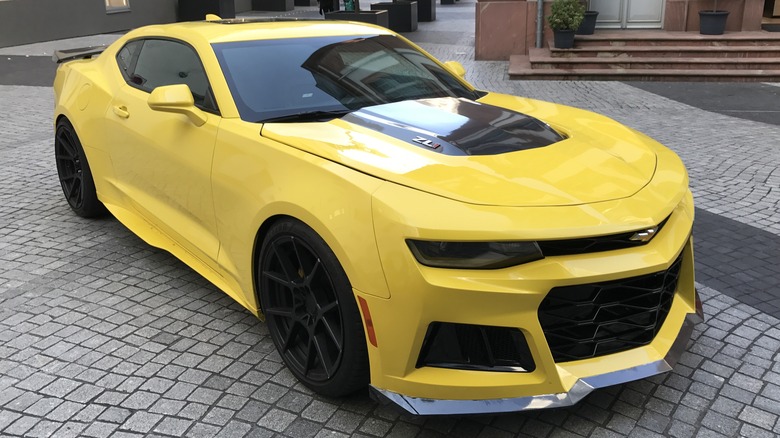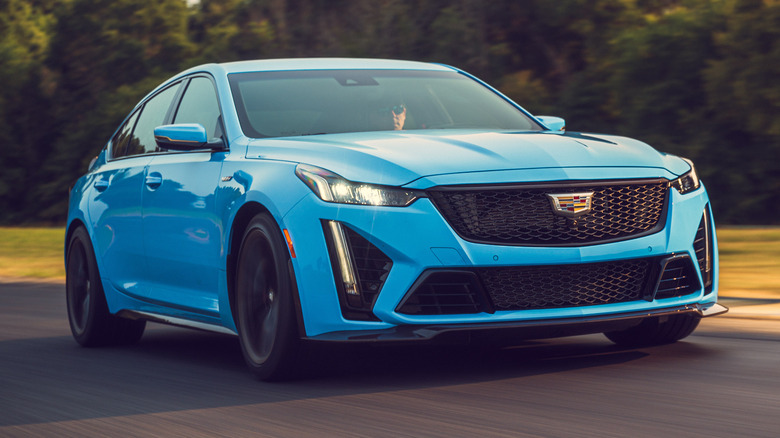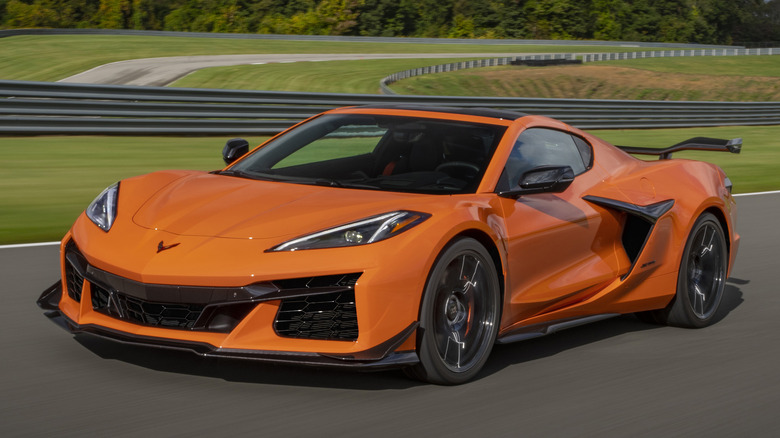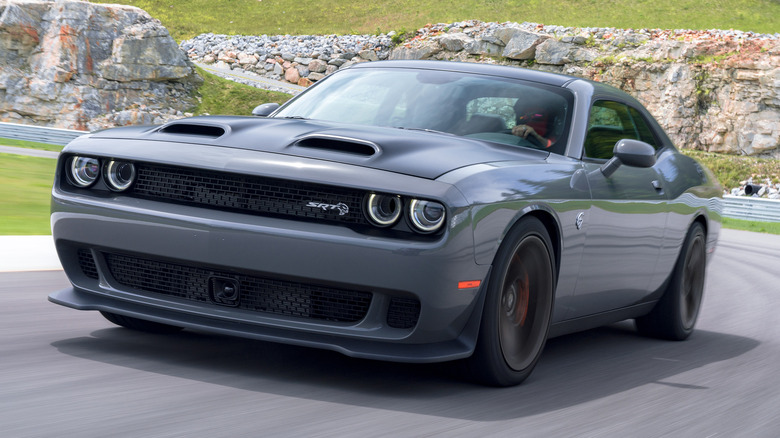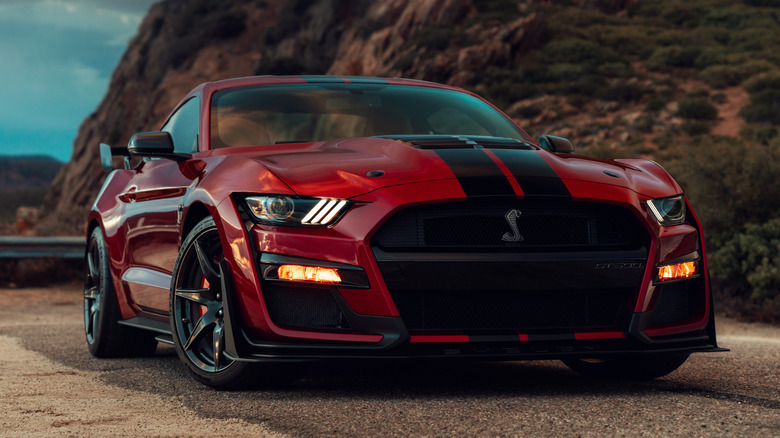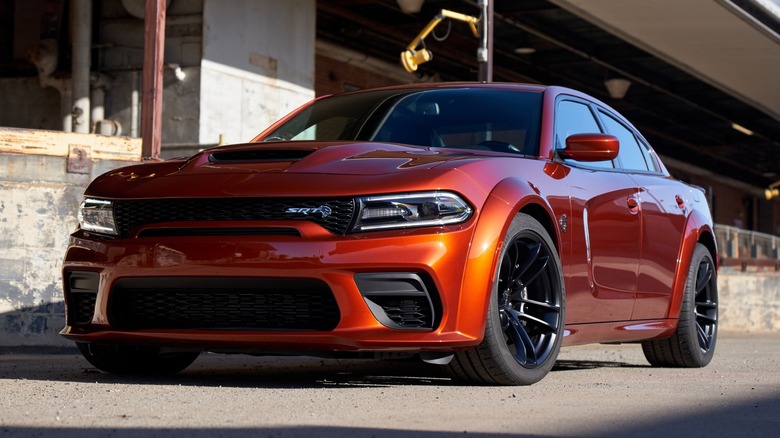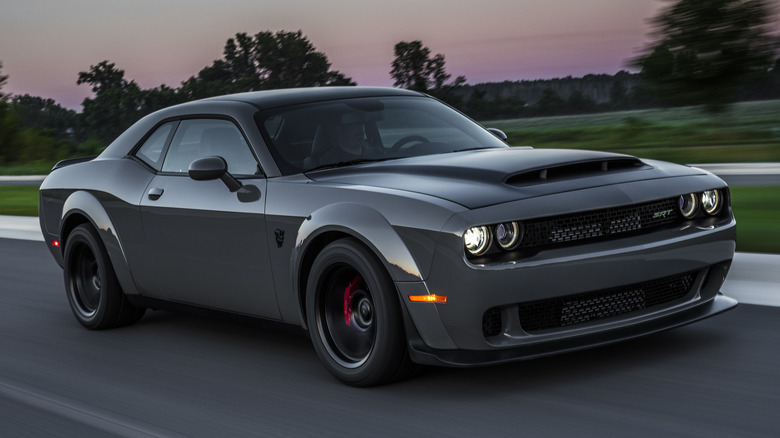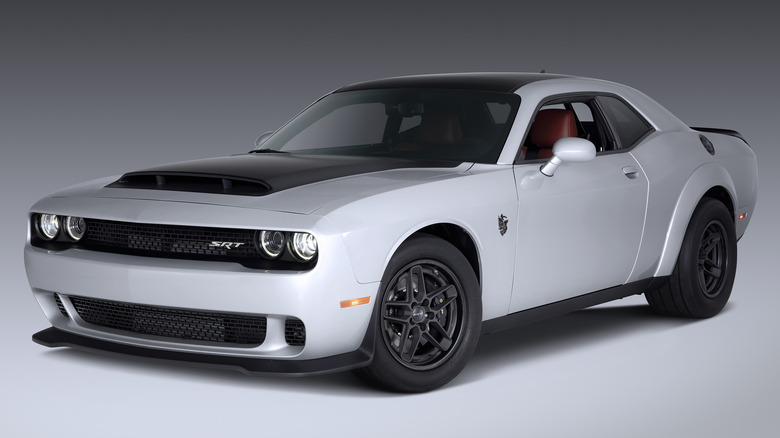10 Of The Highest Horsepower Muscle Cars Ever Made
The modern age of the muscle car as we know it is over. That much is plain to see. Chrysler's ending production of the iconic third-generation HEMI V8 — and with it, the Challenger and Charger as we know it — to replace it with six-cylinder and electric power in cars like the Dodge Charger Daytona and Sixpack, while rival Chevrolet is putting the Camaro on ice before a potential return as an EV. The Corvette arguably isn't much of a muscle car anymore, either, after it went mid-engined in 2020.
In fact, it looks like Ford will soon be the only one of the Big Three still building traditional muscle cars after CEO Jim Farley ruled out an all-electric coupe Mustang in a 2024 interview. But even he wouldn't rule out some level of electrification, stating that hybrid powertrains might be the way forward for high-performance driving.
With all of these changes in the cards, there probably hasn't ever been a better time to look back and celebrate all the crazy high-horsepower production muscle cars that have graced the streets over the past couple decades. Let's take a trip down memory lane and appreciate some of the greatest fruits of the horsepower wars.
Ford Mustang Dark Horse — 500 hp
Ford's Mustang Dark Horse is the latest addition to the Mustang family, and the highest-horsepower version of its seventh-generation 2024 Mustang. The Dark Horse takes the latest Mustang's updated engines, digitalized interior, and refreshed styling to the next level.
The sixth-generation Mustang topped out — at least, in solely Ford-badged guise — with the limited edition Mustang Mach 1, which made 480 hp and 420 lb-ft of torque. But the Dark Horse one-ups the Mach 1 with 500 hp and 418 lb-ft of torque coming from a tweaked version of Ford's legendary 5.0-liter Coyote V8. Ford took a page out of the sixth-gen Ford Shelby Mustang GT500's playbook for the Dark Horse, reusing the piston connecting rods from that 5.2-liter V8. The Dark Horse's Coyote V8 also sports a dual throttle-body intake, which allegedly helps the engine breathe better.
The 500 hp helps 60 mph come in 3.7 seconds, while the quarter-mile passes by in 12 seconds at 118.4 mph, according to MotorTrend's testing. Not the quickest car on our list, but other upgrades such as MagneRide suspension, a Tremec six-speed transmission, an optional Handling Pack, and carbon fiber wheels make it a capable car on twisty tracks as well.
The Mustang Dark Horse is one of the few cars on this list still in production at the time of writing. Prices start at $60,365, and Ford also sells an even more expensive, track-only Dark Horse R for the well-heeled Mustang fan.
Chevrolet Camaro Z/28 (fifth-generation) — 505 hp
The fifth-generation Chevrolet Camaro bowed out with a resurrected Camaro Z/28, the first time that Chevrolet had used the model name since 2002. The Camaro Z/28 was only available for the final two years of fifth-gen Camaro production — 2014 and 2015 — and was second in the horsepower stakes only to the 580-hp fifth-gen ZL1, with 505 hp and 481 lb-ft of torque coming from a 7.0-liter LS7 engine — one of the best LS engine generations ever.
But while the Camaro Z/28 may have lost out in pure horsepower, Chevrolet engineers were chasing a very different goal. The Z/28 was conceived as a track monster, with weight-saving measures allied to components such as Multimatic Dynamic Suspensions Spool Valve dampers, extra-wide Pirelli PZero Trofeo R tires, Brembo carbon ceramic brakes, and a new aero kit for increased downforce. It didn't have the raw power of the ZL1, but the changes made the Z/28 the better car to drive — it was even good enough to win MotorTrend's Best Driver's Car award in 2014.
The Camaro Z/28 was still plenty fast, too. 0 to 60 mph in 4.0 seconds is impressive even in 2024, and its quarter-mile time of 12.3 seconds at 117.2 mph — both as tested by MotorTrend — competes with all but the highest-horsepower versions of Dodge's Charger and Challenger muscle cars. Sadly, Chevrolet opted not to bring the Z/28 back for the Camaro's sixth generation.
Chevrolet Camaro ZL1 (sixth-generation) — 650 hp
Out of all the Chevrolet Camaro trim levels or models to ever exist, the ZL1 has to be the king of the hill. While it started life as a semi-official COPO Camaro in 1969, Chevrolet would eventually embrace the ZL1 brand for the fifth and sixth-generation Camaros, resulting in some of the highest-horsepower Camaros to ever hit the streets.
The fifth-generation ZL1 already had an impressive 580 hp thanks to a supercharged 6.2-liter LSA V8, one of the most powerful engines ever put in a Camaro. Chevrolet didn't stop there, though, and took things a step further when it debuted the sixth-gen Camaro ZL1 in 2017 with a supercharged 6.2-liter LT4 V8 — an improvement over the already-powerful LT1 used in the 1SS and 2SS Camaros — rated at 650 hp and 650 lb-ft of torque under the hood.
Chevrolet claimed a 0 to 60 mph time of 3.5 seconds and a quarter-mile time of 11.4 seconds, with the sixth-gen ZL1 crossing the finish line at an impressive 127 mph. The ZL1 wasn't all brawn, though, with features like a Magnetic Ride suspension, Goodyear Eagle F1 Supercar tires, an electronic limited-slip differential, and high-spec Brembo brakes all contributing to create a well-rounded car — one that contemporary reviewers compared favorably to hoity-toity continental sports cars from the likes of BMW and Mercedes-Benz.
The Camaro ZL1 is still in production, although 2024 is the last year you can buy one in its current form. Prices start from $72,100.
[Image by Ominae via Wikimedia Commons | Cropped and scaled | CC BY-SA 4.0]
Cadillac CT5-V Blackwing — 668 hp
General Motors' supercharged 6.2-liter LT4 — which first debuted in the 2015 Corvette Z06 — did wonders in the Camaro ZL1's engine bay, so it's not surprising that it turned to the engine again for the 2022 Cadillac CT5-V Blackwing. But Cadillac didn't just drop the exact same engine into the CT5-V's engine bay: Instead, the CT5-V's LT4 makes 668 hp and 659 lb-ft of torque, putting it ahead of the Camaro ZL1 and earning it the title of the fastest and most powerful production Cadillac ever when it debuted.
Cadillac claimed 0 to 60 mph and quarter-mile times of 3.4 and 11.3 seconds, respectively — impressive results that were echoed in MotorTrend's tests. But Cadillac wasn't just after straight-line speed with the CT5-V. To prove the car's on-track credentials, Cadillac Arabia strapped current F1 Academy driver Amna Al Qubaisi behind the wheel in 2022, asking her to send it around the famous Yas Marina circuit. The Blackwing earned another accolade in the process, its 2:20:98-second lap making it the fastest production sedan to ever lap the circuit.
It's a record that still stands, as far as we can tell — although that may just be because no other company has felt the need to challenge it. Still, the CT5-V Blackwing's lap isn't anything to sneeze at, especially considering it has four doors and weighs over 4,000 pounds. The Cadillac CT5-V Blackwing is alive and well, with Cadillac announcing a mostly aesthetic 2025 refresh in early 2024; you can make one yours starting from $93,495.
Chevrolet Corvette Z06 (C8) — 670 hp
The modern Corvette is a big departure from its forebears, with a mid-engined layout that arguably places it in the same rarefied atmosphere as the Ferraris and Lamborghinis of the world. Muscle cars, after all, don't do mid-engined layouts. But to deny the Corvette muscle car status would be a disservice to the heritage of iconic Chevrolet Corvettes like the C3 Stingray, so it still counts in our book.
The 2020 Corvette Stingray debuted with a 6.2-liter LT2 V8 making a maximum of 495 hp and 470 lb-ft of torque, which was already impressive for an entry-level Corvette. But it didn't take long for Chevrolet to up the stakes even more, announcing the Corvette Z06 for the 2023 model year with an all-new 5.5-liter LT6 V8 in the engine bay.
Unlike the Camaro ZL1's supercharged LT4, the LT6 is naturally aspirated. In fact, GM claims it's the most powerful naturally aspirated production V8 ever, with 670 hp and 460 lb-ft of torque on tap. That's good enough to propel the Z06 to 60 mph in just 2.6 seconds, which, combined with Z06's other changes — such as a wider stance, an adjustable rear spoiler, and retuned suspension — made for a car that the automotive press — including our very own Tim Stevens — couldn't stop raving about,
Yes, $112,700 is expensive for a Corvette, and there's no way around that. But that's something of a bargain for genuine Ferrari-bothering performance on road and track.
Dodge Challenger SRT Hellcat — 717 hp
If we had to pick one modern muscle car as the most influential ever, it would probably be the 2015 Dodge Challenger SRT Hellcat. 600-hp muscle cars weren't entirely uncommon at that point (witness the fifth-generation Chevrolet Camaro ZL1 and its 580-hp engine), but none had cracked the 700-hp barrier until Chrysler unleashed the Hellcat on the automotive world.
The resurrected Dodge Challenger had been getting by with 400 to 500-hp third-generation Hemi engines up until then, which already ranked as some of the most powerful engines ever put in a Challenger. But Dodge took things to a new level with the SRT Hellcat and its supercharged 6.2-liter HEMI V8. Dodge's new Hellcat engine made 707 hp and 650 lb-ft of torque, aided by a twin-screw supercharger running at 11.6 psi and displacing 2.4 liters. The result? A 0 to 60 time of 3.7 seconds, with the quarter mile coming up in 11.7 seconds at 125 mph, as tested by MotorTrend.
Chrysler proclaimed that the Hellcat engine was the most powerful V8 engine it had ever made, but the company didn't stop there. It bumped the Hellcat V8's power output up to 717 hp and 656 lb-ft of torque in 2019, alongside the even more powerful Hellcat Redeye — more on that one later, though. The Challenger SRT Hellcat was a mainstay in the Dodge Challenger lineup until Chrysler discontinued the HEMI engine — and HEMI-powered Challengers — in 2023.
Ford Mustang Shelby GT500 — 760 hp
Carroll Shelby's name has been almost synonymous with high-performance Mustangs going back to the 1965 Ford Shelby Mustang GT350 and 428 Cobra Jet-powered Fords like the 1968 Mustang Shelby Cobra GT500KR. But while Shelby contributed his name and expertise to a handful of special Mustangs, none were ever quite as special as the 2020 Ford Mustang Shelby GT500.
The 2020 GT500 was the third Mustang to carry the model number, after the aforementioned GT500KR and the 2007 Shelby GT500. It was also the first GT500 to debut after Shelby's passing in 2012. Ford pulled out all the stops when developing the third-generation GT500, coaxing 760 hp and 625 lb-ft of torque from a supercharged, hand-built 5.2-liter aluminum V8 — enough to make it the most powerful street-legal Ford ever. But while the powerplant was undoubtedly the highlight, the GT500 was also quite a sophisticated car in other areas, with a dual-clutch seven-speed transmission, MagneRide suspension, and Brembo brakes rounding out the package.
MotorTrend managed a 0 to 60 time of 3.7 seconds and a mid-11-second quarter-mile time, with the latter coming at around 130 mph. Competitive numbers for sure, but there was more to the GT500 than straight-line performance: Contemporary reviews highlighted its on-track prowess, with some outlets hailing it as something of a supercar killer — albeit with an optional Carbon Fiber Track Package.
The Ford Mustang Shelby GT500 was only available for a couple of years. As of mid-2024, Ford hasn't indicated whether it'll bring the GT500 back for the seventh-generation Mustang.
Dodge Charger SRT Hellcat Redeye Jailbreak — 807 hp
The Challenger may have been the flag-bearer for Chrysler's horsepower push in the late 2020s, but it wasn't the only model the company chose to bless with the high-output version of its 6.2-liter supercharged HEMI V8 seen in a handful of Challenger variants.
Chrysler introduced the revived Charger to its stable in 2006, a couple of years before its two-door relative would hit the streets. Like the Challenger, Charger power levels would creep inexorably upward over its life, with the 340- and 425-hp HEMI V8s of its debut year well and truly forgotten once Chrysler introduced the Charger SRT Hellcat Redeye in 2021. The Hellcat Redeye produced 797 hp and 707 lb-ft of torque, courtesy of the same supercharged 6.2-liter HEMI in high-powered Challengers like the Redeye and Super Stock.
The engine's copious power meant claimed 0-to-60-mph and quarter-mile times of 3.6 and 10.6 seconds — competitive with the upcoming Dodge Charger Scat Pack, even with the torque advantages of electric motors. While independent testers couldn't quite match Chrysler's numbers due to traction issues, none could deny the engine's pulling power and infectious performance, even if drivers were in for an expensive time at the pumps.
Chrysler added just that little bit more in 2023, introducing the 807 hp Hellcat Redeye Jailbreak in 2023 as a final hurrah for the HEMI. The extra 10 hp came from a "revised powertrain calibration," in Chrysler's words, although torque remained the same at 707 lb-ft.
Dodge Challenger SRT Demon — 840 hp
Dodge introduced the Challenger SRT Demon as a limited-edition, one-year-only version of the Challenger in 2018 with an ultra-special version of the supercharged 6.2-liter Hellcat HEMI V8 under the hood. The Demon's V8 shared the Hellcat's displacement but featured many changes that set it apart from its predecessor. These included a new engine block, crankshaft, pistons, connecting rods, and an even beefier supercharger.
The Demon V8's twin-screw supercharger displaced 2.7 liters (instead of the Hellcat engine's 2.4 liters) and ran at a higher 14.5 psi. When fed with 100-octane race fuel, the Challenger SRT Demon made a massive 840 hp and 770 lb-ft of torque, with numbers dropping to 808 hp and 717 lb-ft on regular 91-octane pump gas. Chrysler made a huge song and dance about the SRT Demon's performance in its promotional material, boasting proudly that the NHRA had banned it for hitting a 9.65-second quarter-mile time.
Chrysler's claimed 0 to 60 mph time was no less impressive, with the Demon allegedly managing that feat in 2.3 seconds. It wasn't all talk, either, and independent reviewers managed to come close without having much in the way of drag racing chops — aided, no doubt, by the Demon's launch control. Chrysler only built 3,300 SRT Demons but would reuse the engine in its pump gas tune for the SRT Challenger Redeye, Redeye Jailbreak, and Super Stock — the former with 797 hp and the latter two getting 807 hp.
Dodge Challenger SRT Demon 170 — 1,025 hp
For a while, it seemed like the 840-hp Challenger SRT Demon from 2018 was the most powerful production muscle car we would ever see. But Dodge and SRT had one more trick up their sleeves for 2023: an epic, drag-strip-destroying final farewell to the internal combustion Challenger as we know it, called the Dodge Challenger SRT Demon 170.
The SRT Demon 170 was part of Dodge's "Last Call" series, released to celebrate the end of the Challenger and Charger in their gasoline-powered HEMI guises. The Demon 170 was the final model to be unveiled, and Chrysler certainly saved the best for last. For the Demon 170, SRT engineers upgraded the 6.2-liter HEMI from the 2018 Demon with a bigger 3.0-liter supercharger and all-new internals, bringing power numbers to a scarcely-believable 1,025 hp and 945 lb-ft on E85.
Alongside other changes such as a drag suspension, new driveline, beefy drag radials, and new TransBrake software, the Demon 170 was capable of a claimed 0 to 60 mph time of just 1.66 seconds and an equally impressive quarter-mile time of 8.91 seconds — albeit both on a prepared drag-racing track and not on the street. The Demon 170 was no slouch on E10 pump gas, either; its 900 hp and 810 lb-ft of torque placed it leagues ahead of other muscle cars, even when not at full strength.
This much power didn't come cheap, though, with prospective owners having to cough up more than $100,000 for the privilege of owning one of only 3,000 Demon 170s available in the U.S.
